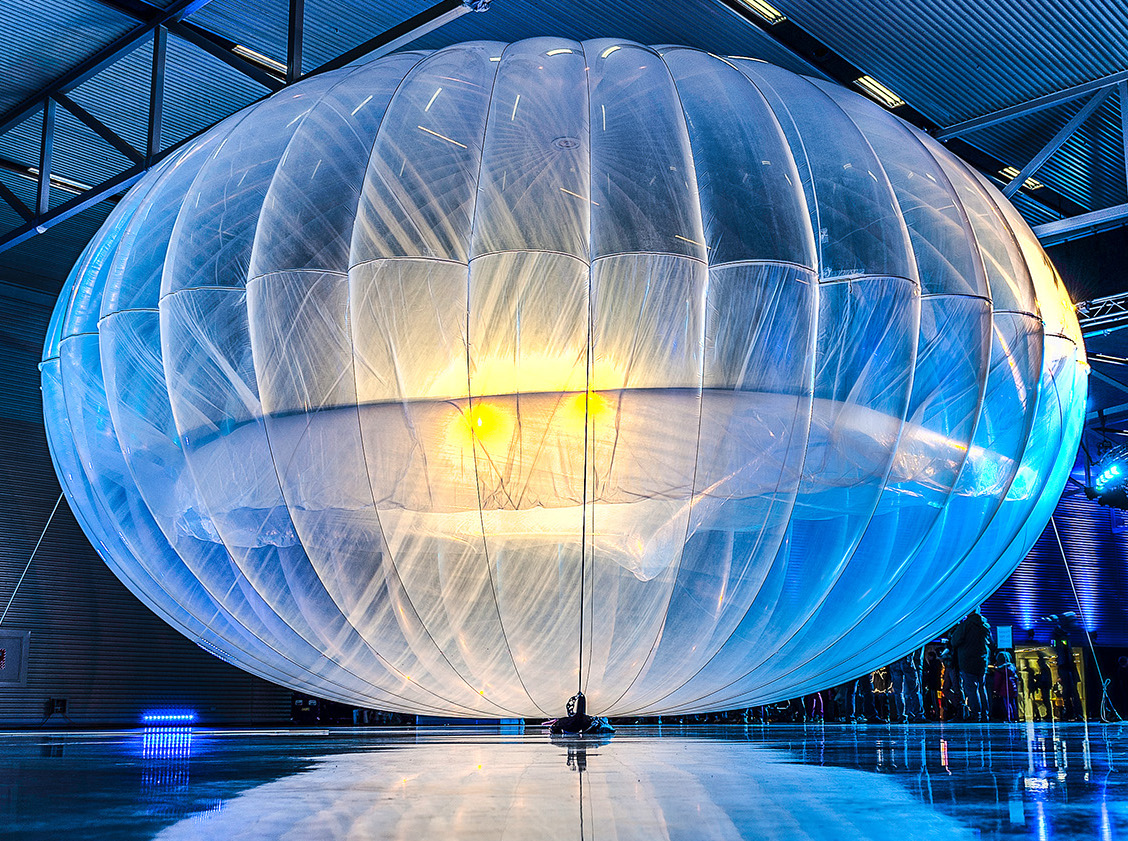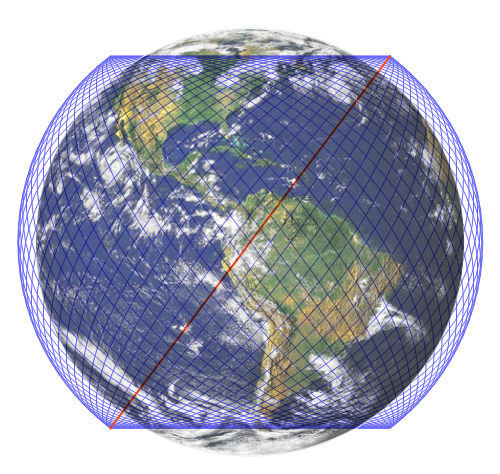
Google/Alphabet Loon. Image: wikimedia
Wave Goodbye to Loon. The visionary project, to beam down the Internet from floating balloons, called it quits. For nine years, Google/Alphabet sent up as many as 35 floating globes – the size of tennis courts – with the goal of transmitting internet capability to areas where land-based infrastructure is not feasible. Of course, the balloons used Google autonomous navigation technology to steer themselves. But this week, the start up wound down. In 2017, when Hurricane Maria wiped out Puerto Rico’s telecommunications system, Loon helped to get the island back online. Another good outcome: Telkom, a telecommunications company in Kenya, inked a deal to bring 4G to remote areas. Because almost half the world does not yet have internet access, it’s a big market. Land-based technologies picked low-lying fruit, but there is still room for growth – above.

Starlink satellites stacked and ready to launch. Image: SpaceX and wikimedia commons.
Flying internet is a rapidly developing sector. Since early days of COMSAT, satellites are proving better vehicles for connectivity, even to what some call “notspots” (Kleinman 2021) with a vision of bringing the whole world online. It’s a movement that recalls the achievements such as the telephone and telegraph (connections were laid under the tracks of the Transcontinental Railroad). Here are some satellite enterprises delivering broadband internet today – and tomorrow:
FLYING INTERNET PROVIDERS
Apple – A plan to develop their own satellites prompted Apple to recruit two Google satellite experts: John Fenwick and Michael Trela will work with Greg Duffy, Dropcam founder who joined Apple recently. Apple may partner with Boeing to launch more than 1,00 low-orbit satellites.
Starlink – Elon Musk’s SpaceX Starlink will require 42,000 satellites. SpaceX launched 60 satellites on 20 January 2021 to tally 1,015 so far (only 951 are still in orbit). In 2020, SpaceX carried out 14 launches. Possible subscription: $99 monthly fee + $499 for hardware.
OneWeb – Founded in 2014 by Greg Wyler, OneWeb re-emerged from potential bankruptcy with help from Bharti Global and UK government. 648 satellites will form OneWeb network constellation. Development of terminals is with Intellian Technologies and Collins Aerospace. Customers? While at first it was rural folks (OneWeb promises they won’t be overlooked), now it is telecom companies. Second generation satellites will include intelligence and security capabilities. New funding from SoftBank Group Corp and Hughes Network Systems/EchoStar tallied $1.4 billion in funding to put first-generation fleet in place in 2022.
Project Kuiper Constellation – Funded by Jeff Bezos, Amazon’s satellite project plans to launch 3,236 satellites. In March 2019, Project Kuiper filed with the International Telecommunication Union (ITU), and Federal Communications Commission. The satellite array will orbit at three altitudes: 784 satellites at 367 miles (590 kilometers); 1,296 satellites at 379 miles (610 kilometers), and 1,156 satellites at 391 miles (630 kilometers). The plan is to provide coverage from latitude 56 degrees north to 56 degrees south – that’s where 95% of the world’s people live. (Boyle 2019)
Telesat – With priority Ka-band spectrum rights and a fifty-year history of technical prowess, Telesat Low Earth Orbit (LEO) will link to customer terminals and electronically steered antennas (ESAs) for commercial, government, and military use. The first launch happened in January 2018.
LeoSat – The vision was a constellation of 78 -108 satellites but in 2019 the company laid off its 13 employees after investors dropped support. The investors were Hispasat, Spanish satellite operator, and Sky Perfect JSat of Japan. LeoSat still exists but for now is dormant.
Viasat – This satellite system offers internet access from geosynchronous orbit. New entrants like Starlink, OneWeb, Kuiper, Telesat will use Low Earth Orbit (LEO) for lower latency and lower cost.
03b – Using medium Earth orbit (MEO), this constellation offers fiber-equivalent connection. The prime contractor is Arianespace for the operator SES Networks.
Athena – Facebook filed with the Federal Communications Commission to launch Athena to provide broadband access to “unserved and underserved” areas of the world. The filing included a new name: PointView Tech LLC.
Boeing – The aerospace giant plans to launch and operate 147 satellites for a broadband constellation. Apple may help.

Satellites: a traffic jam in the sky? Can astronomers still see the stars? Image: Starlink, initial phase – wikimedia.
PROBLEMS: Are satellite constellations the new Milky Way, or are we creating the same kind of traffic jam above that we suffer from on land? Some astronomers already report difficulty in seeing the sky. Negative comments from astronomers caused Starlink satellites to come up with a visor that prevents sun reflection, reducing glare – its a sub-company called VisorSat. OneWeb chair Sunil Bharti Mittal pledges environmental stewardship, working with astronomers on issues like reflectivity. (Amos, 2020) And then there is the problem of space debris: getting satellites up is easier than getting them down,
OPPORTUNITIES: Why are so many players entering the flying internet competition. Opportunity: Morgan Stanley projected that “the global space industry could generate revenue of $1.1 trillion or more in 2040, up from $350 billion today.” (Conroy 2019) Of that, $410 billion will come from satellite-based internet services.

GPS Constellation. Image: wikimedia
Amos, Jonathan. “OneWeb satellite company launches into new era.” 18 December 2020. BBC.com
Boyle, Alan. “Amazon to offer broadband access from orbit with 3,236-satellite ‘Project Kuiper’ Constellation.” 4 April 2019. GeekWire. https://www.geekwire.com/2019/amazon-project-kuiper-broadband-satellite/
Foust, Jeff. “SpaceX surpasses 1,000-satellite mark in latest Starlink launch.” 20 January 2021. SpaceNews.com. https://spacenews.com/spacex-surpasses-1000-satellite-mark-in-latest-starlink-launch/
Henry, Caleb. “LeoSat, absent investors, shuts down.” 13 November 2019. SpaceNews.com. https://spacenews.com/leosat-absent-investors-shuts-down/
Kleinman, Zoe. “Satellites beat balloons in race for flying internet.” 25 January 2020. BBC.com/Tech. https://www.bbc.com/news/technology-55770141
Matsakis, Louise. “Facebook Confirms It’s Working on a New Internet Satellite.” 28 July 2018. Wired. https://www.wired.com/story/facebook-confirms-its-working-on-new-internet-satellite/
OneWeb. “OneWeb Secures Investment from Softbank and Hughes Network Systems.” 15 January 2021. https://www.oneweb.world/media-center/oneweb-secures-investment-from-softbank-and-hughes-network-systems
Raymundo, Oscar. “Apple is reportedly looking to put broadband-beaming satellites into orbit.” 21 April 2017. Macworld. https://www.macworld.com/article/3191474/apple-is-reportedly-looking-to-put-broadband-beaming-satellites-into-orbit.html
Yan Huang, Michelle, Bob Hunt, David Mosher. “What Elon Musk’s 42,000 Starlink satellites could do for – and to – planet Earth.” 9 October 2020. Business Insider. https://www.businessinsider.com/how-elon-musk-42000-starlink-satellites-earth-effects-stars-2020-10
Building the World Blog by Kathleen Lusk Brooke and Zoe G. Quinn is licensed under a Creative Commons Attribution-NonCommercial-NoDerivs 3.0 Unp

